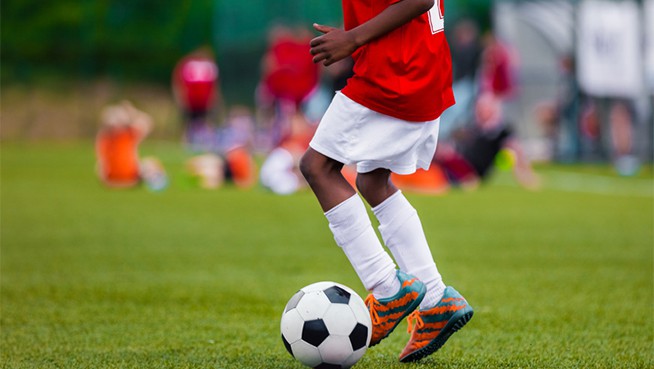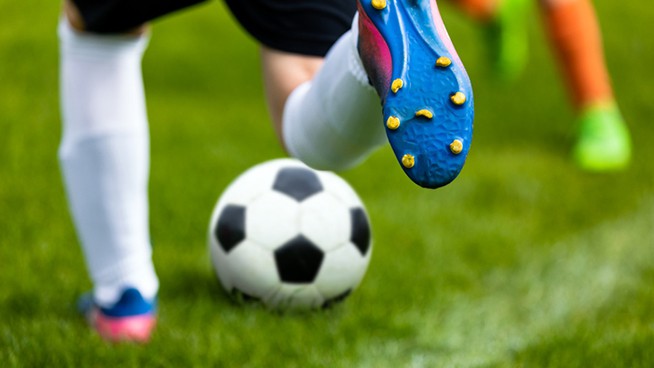Turn Your Weight Room Strength into More Powerful Football Tackles
You spend all summer packing on pounds of weight on the scale and adding plates to the bar. You train Squats, Presses, Pulls and their variations with the goal of turning into moving bombs of instantaneous power. But come game day, if you can’t translate that power to the football field, you might as well have spent the summer watching Netflix and playing video games instead of improving your tackling power.
Integrating weight-room strength into sport-specific movements is important. This is often the time when strength coaches get very technical and elaborate, throwing their players into One-Legged Hops and Sequenced Bounds. After all, plays do not consist of Bench Presses and Squats. They consist of dynamic, multi-planar, often unbalanced movements involving split-second reactions and a high degree of autonomous creativity.
Applying specific drills and exercises, no matter what you call them (I refer to them here as integration training), is much like building the metaphorical bridge that takes an everyday power lifter to the skill set of an explosive athlete and turns otherwise semi-decent hits into more powerful tackles that will surely bring down the ball carrier in his tracks.
RELATED: 5 Self-Tests You Must Do Before Off-Season Training
Translating Force
I referred to the kinetic chain in a previous article, and if you’re unfamiliar, I highly recommend you read up on it. The basic idea is that muscles and joints create a sort of system of moving pieces that only function as well as its weakest link. The lower body, for example, can produce a ton of force. But if the core is not strong enough, it may give way before that force can be transferred to an opponent.
This is why bench pressing 500 pounds does not always make a powerful blocker. You might be able to press a ton when the counterpoint is a stationary bench, but when the counterpoint is an ever-changing point of contact on the ground, you need balance and leverage. At the very least, you need to support the strength you produce with your arms through your core and lower body, so you don’t crumble the second you drive into a block.
Combination movements are great tools to use near the end of a strength training program. These include integrating two exercises into one (often full-body) movement. Some common examples: Squat Presses, Mid- and High Pulls, Lunges with Medicine Ball Throws and various free-form cable movements. The idea is not to create mechanical overload or metabolic stress as you would with single exercises, but simply to integrate the two movement patterns so they flow seamlessly to mimic sport-specific patterns.
RELATED: Unstoppable Exercise Pairs
Quick feet drills are a crucial part of gaining the solid base you need to translate force. Although they are practiced year round, they are emphasized the month before and during the season. If you get caught with your feet in the wrong position, you’ll be at the mercy of your opponent, no matter how strong you are. Ladder drills, T-drills, and most blocking and tackling drills rely more on the ability to quickly move your feet than the ability to create overall speed. Quick feet are paramount not only in football, but also in any sport that requires dynamic movement and force production. Boxing is a great example. You can immediately see how a boxer creates force from his hips, transferring it in two directions—the opponent and the ground. If your feet are out of position, your punch becomes considerably weaker.
Athletic position is a key to delivering all your strength and power so it can be used for mechanical advantage. With all the joints of your lower body slightly open (ankles, knees, hips), you will be in position to produce the highest amount of instantaneous force. Drop your butt too much in a three-point stance, and guess what: you lose your mechanical advantage. Practice athletic positions until you can do them in your sleep. All too often, coaches see athletes miss blocks and tackles due to improper position late in games. Positioning is also important for safety, since many injuries occur when athletes are fatigued and stoop or hunch their way to improper form.
Dynamic movements are next in the hierarchy. They can be anything from sequenced Step-Ups to reactive agility drills, and even plyometric exercises. The key to all, however, is body position. As you make strides, cuts and blocks, you need to align your feet to your center of gravity as quickly as possible, positioning that allows you to drive through the ground in a manner that transmits force directly into your opponent. Refining counter-movements is another key to creating those immediate bursts of speed and power. Many sport-specific workouts focus on exercises such as plyometric drills for this reason.
By now you should have a sense of why squatting 500 pounds won’t necessarily make you an athlete (at least in the dynamic sense). But you can imagine how an athlete who can react in an instant, immediately get into position, and muster 500 pounds of force could be one heck of an obstacle for his opponent. The amount of force necessary to stop and start on a dime is exponentially higher than what you need to simply maintain propulsion. The ability to move heavy weight in the gym definitely serves you well on the field, but only if you can integrate that strength into your sport-specific skill set.
RECOMMENDED FOR YOU
MOST POPULAR
Turn Your Weight Room Strength into More Powerful Football Tackles
You spend all summer packing on pounds of weight on the scale and adding plates to the bar. You train Squats, Presses, Pulls and their variations with the goal of turning into moving bombs of instantaneous power. But come game day, if you can’t translate that power to the football field, you might as well have spent the summer watching Netflix and playing video games instead of improving your tackling power.
Integrating weight-room strength into sport-specific movements is important. This is often the time when strength coaches get very technical and elaborate, throwing their players into One-Legged Hops and Sequenced Bounds. After all, plays do not consist of Bench Presses and Squats. They consist of dynamic, multi-planar, often unbalanced movements involving split-second reactions and a high degree of autonomous creativity.
Applying specific drills and exercises, no matter what you call them (I refer to them here as integration training), is much like building the metaphorical bridge that takes an everyday power lifter to the skill set of an explosive athlete and turns otherwise semi-decent hits into more powerful tackles that will surely bring down the ball carrier in his tracks.
RELATED: 5 Self-Tests You Must Do Before Off-Season Training
Translating Force
I referred to the kinetic chain in a previous article, and if you’re unfamiliar, I highly recommend you read up on it. The basic idea is that muscles and joints create a sort of system of moving pieces that only function as well as its weakest link. The lower body, for example, can produce a ton of force. But if the core is not strong enough, it may give way before that force can be transferred to an opponent.
This is why bench pressing 500 pounds does not always make a powerful blocker. You might be able to press a ton when the counterpoint is a stationary bench, but when the counterpoint is an ever-changing point of contact on the ground, you need balance and leverage. At the very least, you need to support the strength you produce with your arms through your core and lower body, so you don’t crumble the second you drive into a block.
Combination movements are great tools to use near the end of a strength training program. These include integrating two exercises into one (often full-body) movement. Some common examples: Squat Presses, Mid- and High Pulls, Lunges with Medicine Ball Throws and various free-form cable movements. The idea is not to create mechanical overload or metabolic stress as you would with single exercises, but simply to integrate the two movement patterns so they flow seamlessly to mimic sport-specific patterns.
RELATED: Unstoppable Exercise Pairs
Quick feet drills are a crucial part of gaining the solid base you need to translate force. Although they are practiced year round, they are emphasized the month before and during the season. If you get caught with your feet in the wrong position, you’ll be at the mercy of your opponent, no matter how strong you are. Ladder drills, T-drills, and most blocking and tackling drills rely more on the ability to quickly move your feet than the ability to create overall speed. Quick feet are paramount not only in football, but also in any sport that requires dynamic movement and force production. Boxing is a great example. You can immediately see how a boxer creates force from his hips, transferring it in two directions—the opponent and the ground. If your feet are out of position, your punch becomes considerably weaker.
Athletic position is a key to delivering all your strength and power so it can be used for mechanical advantage. With all the joints of your lower body slightly open (ankles, knees, hips), you will be in position to produce the highest amount of instantaneous force. Drop your butt too much in a three-point stance, and guess what: you lose your mechanical advantage. Practice athletic positions until you can do them in your sleep. All too often, coaches see athletes miss blocks and tackles due to improper position late in games. Positioning is also important for safety, since many injuries occur when athletes are fatigued and stoop or hunch their way to improper form.
Dynamic movements are next in the hierarchy. They can be anything from sequenced Step-Ups to reactive agility drills, and even plyometric exercises. The key to all, however, is body position. As you make strides, cuts and blocks, you need to align your feet to your center of gravity as quickly as possible, positioning that allows you to drive through the ground in a manner that transmits force directly into your opponent. Refining counter-movements is another key to creating those immediate bursts of speed and power. Many sport-specific workouts focus on exercises such as plyometric drills for this reason.
By now you should have a sense of why squatting 500 pounds won’t necessarily make you an athlete (at least in the dynamic sense). But you can imagine how an athlete who can react in an instant, immediately get into position, and muster 500 pounds of force could be one heck of an obstacle for his opponent. The amount of force necessary to stop and start on a dime is exponentially higher than what you need to simply maintain propulsion. The ability to move heavy weight in the gym definitely serves you well on the field, but only if you can integrate that strength into your sport-specific skill set.










